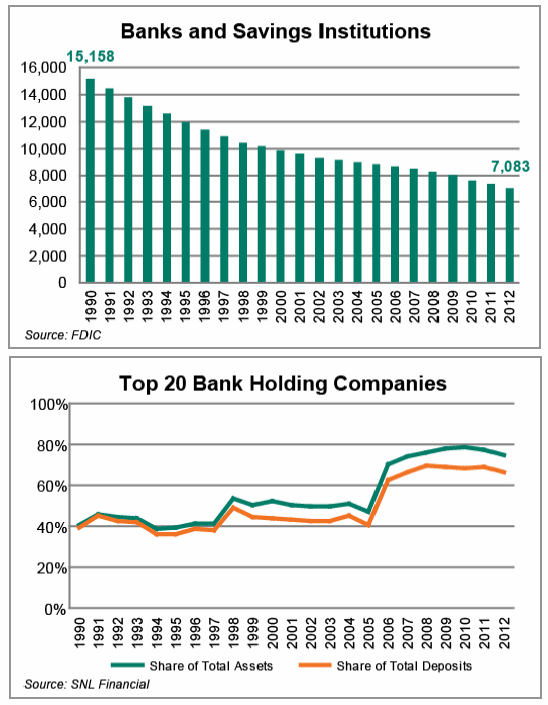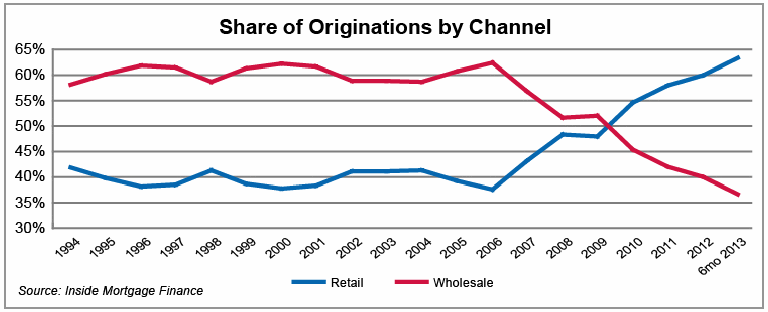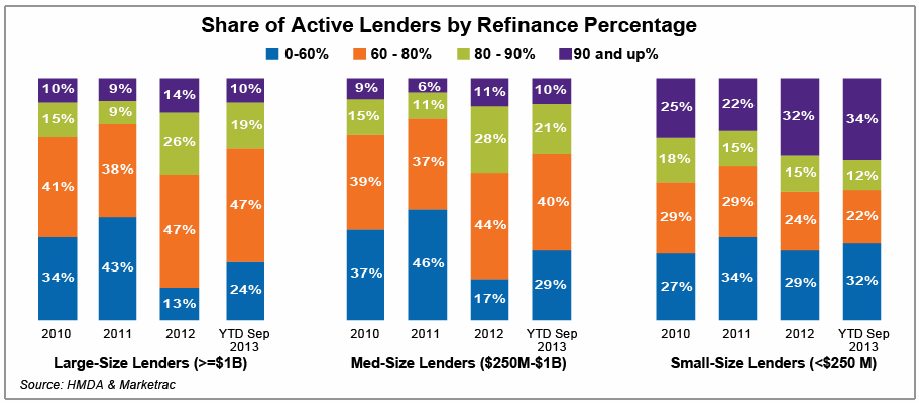Too Big to Fail Banks and the financial consolidation that created them are hot topics. A famous chart from Mother Jones shows that the big four banks (Citi, JP Morgan Chase, Bank of America, and Wells Fargo) got that way by swallowing up 33 other large banks since 1990. The chart does not reflect many of the smaller local and regional banks that were already in the bellies of the regional banks that disappeared.
Both independently and because of this mortgage lending was also contracting rapidly. Fannie Mae's Economic & Strategic Research Group says that the share of the mortgage market held by the top ten originators doubled, from just below 40 percent in 1998 to nearly 80 percent by 2010. But recently that trend reversed. In one of its regular Housing Insights reports the group says that over the last three years "the market has experienced significant deconsolidation as top lender share retreated to slightly more than 60 percent in the first half of 2013. Market deconsolidation was driven largely by the withdrawal of large lenders, with only 5 of the top 20 single-family mortgage originators in 2006 remaining active in the market today."
The authors of Deconsolidation in the Primary Mortgage Market: Temporary or Structural Trend? point out that "Increasing [primary market] concentration by one standard deviation reduces the overall impact of a decline in MBS yields by approximately 50 percent."
Their paper attempts to answer the question posed by its title; is this decline in the share of the market held by top lenders temporary or permanent? Is it a function of cyclical or structural market factors?
Economies of scale and scope is the first structural factor favoring large mortgage lenders. They can spread fixed costs across more loans, reducing the average production expenses of each. The authors cite servicing as an example. Figures from the Mortgage Bankers Association (MBA) for the four quarters ended in March 2013 show that direct servicing expenses for servicers who handled fewer than 2,500 loans were 13 percent higher per loan than for those servicing more than 50,000 loans.
In this same vein, larger lenders are able to offer a wider variety of products and services and further distribute fixed costs against other lines of business. They are also in a better position to cross sell mortgage products to non-mortgage customers of these other profit centers.

Second, larger banks generally have lower debt costs and broader access to funding in the bond market than smaller lenders. Goldman Sachs estimates that large banks have had an average advantage of 31 basis points in the cost of debt since 1999 but during the financial crisis this expanded to 800 points. Today however they are at a 10 basis point disadvantage. The authors say the average tangible common equity ratio (TCER) for small banks is also meaningfully higher than it is for the largest U.S. banks.
Another factor favoring large lenders arises out of the combination of tighter credit standards and the government's responses to the financial crisis. These have led to a more standardized and commoditized mortgage market. This will likely make operating costs more important in competition than the value of product and service differences.
Fourth, larger banks are better positioned than smaller ones to obtain the help of experts. This will help them navigate the increasingly complex areas such as compliance and financial modeling.
The fifth advantage arises out of the consolidation of the banking industry independent of any mergers and acquisitions related to their mortgage business. Between 1990 and 2012 the number of U.S. banks and savings institutions declined by more than 50 percent and the share of assets and deposits held by the top 20 bank holding companies nearly doubled.

The Private Label Securities (PLS) Market for conforming loans went dormant with the financial crisis. It had been significant in attracting private capital and a resurgence in PLS issuance would signal a return of private capital. This would advantage large lenders who can gather the required collateral and perform necessary securitization and servicing functions.
On the other side of the ledger are factors the authors identify as favoring less consolidation. The first is a shift to retail mortgage origination. A sustained shift in that direction would indicate a future with a more diversified group of originators because larger lenders are more suited for wholesale origination. The authors believe that the shift that has happened since the financial crisis came from lenders' desire to more tightly control underwriting and production because of the weak performance and high defect rates for wholesale originations during the crisis period.

Capacity constraints of the larger banks allow smaller lenders to be relatively more nimble. They can react more swiftly to market changes as they did when refinancing began to drive originations in 2012 as interest rates fell to all-time lows. The recent rise in those rates could, however, test that nimbleness as refinancing gives way to a purchase dominated market.

Another advantage of smaller lenders is their knowledge of their own markets. This was manifest in the superior performance of small bank originated single-family loans during the recent crisis and fairly consistently since 1992. The authors say that this discrepancy might also be explained by a different risk appetite between large and small banks.
Small lenders are spared some of the enhanced regulatory and supervisory requirements of large institutions such as increased capital standards and stress tests. Heightened requirements may be one factor that will discourage banks from holding mortgage servicing rights (MSR) assets.
Both large and small lenders received loan repurchase requests from secondary market participants. The authors say a significant number of legacy issues have now been resolved and should recede as a business issue.
After weighing all of these factors the authors conclude that the recent decline in the large lender share of the mortgage market is temporary and principally a result of cyclical factors. Their analysis did not consider possible changes to the housing finance system but absent "meaningful restructuring" they believe there is a significant probability that in the long term the large bank share will increase.
Of the eight factors they outline that favor consolidation, all are what they consider to be sustainable in the mid-term. However, of the six that favor deconsolidation, three, capacity limits for large lenders, legacy issues, and a shift to a retail market, they conclude are only temporary conditions. For example, they view the sustainability of the shift to retail as uncertain. "Lender concerns about poor loan performance and repurchase risk are expected to decline as the housing market outlook and manufacturing processes improve, but some smaller lenders are expected to be less willing to sell their mortgage production to larger lenders in the future."







